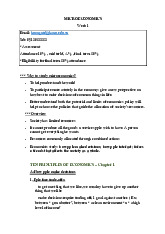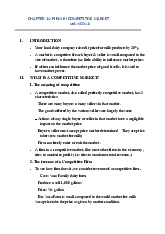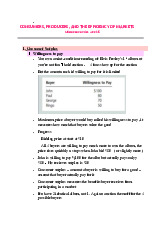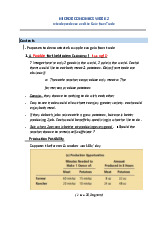





Preview text:
lOMoAR cPSD| 59114765 MIC WEEK 8 CHAPTER 10: EXTERNALITIES Introduction
Market failures fall under a category called externalities.
An externality arises when a person engages in an activity that
influences the well-being of a bystander- a person whose are not
participants in the market at all; but neither of them pay nor
receives any compensation for that effect.
Negative externalities: ( ex: pollution from automobile exhaust
create smog that other pple have to breath => government
attempts to solve the problem by setting emission standard of cars
, also taxing gasoline to reduce the amount pple drive . Pollution
from noise negatively effect pple’s aural health. => Government
solves problem by: setting the rules for businesses with noise have
to locate far away from the residence area, karaoke bars must
have sound-proof walls & doors )
Positive externalities: (ex: restore historic building pple can
enjoy beauty & sense of history that these building provides => Government regulating the
destruction of historic building & providing tax breaks
to owners who restore them . Research into new technologies
create knowledge that pple can use => Government make up
patent system giving inventors exclusive use of their invention for a limited times.
Welfare Economics: a recap -
Consider a specific market – market for Aluminum - Recalled from chap 7
Total surplus = Value to buyers – Cost to sellers Demand curve : reflect value
When a market is in equilibrium: when buyers who value the good
more than the price (ae) choose to buy the good / buyers who
value it less than the price (eb) do not buy lOMoAR cPSD| 59114765
At any quantity below Equilibrium level (Q1), value to buyer > cost
to seller increasing quantity raises total surplus, until quantity reaches E level
The demand curve reflects the value to buyers, and the supply curve reflects
the costs of sellers. The equilibrium quantity, QMARKET, maximizes the total
value to buyers minus the total costs of sellers. In the absence of externalities,
therefore, the market equilibrium is efficient.
Negative externalities
- This intersection determines the optimal amount of aluminum from
the standpoint of society as a whole
- QMARKET, is larger than the socially optimal quantity, QOPTIMUM.
This inefficiency occurs because the market equilibrium reflects only
the private costs of production. In the market equilibrium, the
marginal consumer values aluminum at less than the social cost of
producing it. That is, at QMARKET, the demand curve lies below the
social-cost curve. Thus, reducing aluminum production and
consumption below the market equilibrium level raises total economic wellbeing lOMoAR cPSD| 59114765
Bcs of the externality, cost to society of producing AI is larger than the cost to the AI producer
- How can the social planner achieve the optimal outcome?
+ tax aluminum producers for each ton of aluminum sold. The tax
would shift the supply curve for aluminum upward by the size of the
tax. If the tax accurately reflected the external cost of pollutants
released into the atmosphere, the new supply curve would coincide
with the social-cost curve. In the new market equilibrium, aluminum
producers would produce the socially optimal quantity of aluminum.
Aluminum producers would take this cost of releasing pollutants to the air
- Market price would be with tax ( on producers )
This policy is based on the principle : pple respond to incentives.
Positive Externalities
- Some activities impose cost on third parties, others yield benefits ( ex: education)
- To a large extent, the benefit of education is private:
- Beyond private benefit, education also yields positive externalities
- More educated population leads to more informed voters, tends to
mean lower crime rates, lead to higher productivity n higher wages for everyone,. lOMoAR cPSD| 59114765
- Government can correct the market failure by inducing market
participants to internalize externality
- Negative externalities lead markets to produce a larger quantity than socially desirable
- Positive externalities lead market to produce a smaller quantity than socially desire.
Public policies toward Externalities -
Government can respond to externalities in 1 of 2 ways
+ Command- and- control policies + Market-based policies -
Government can remedy an externalities by making certain
behaviors either required or forbidden (ex: it’s a crime to dump poisonous..)
Command-and Control Policies: regulation -
It’s impossible to prohibit all polluting activities ( ex: all form of
transportation produce some undesirable polluting by product. For
cars n motorbikes under operation, polluted gas discharge into the air ) -
Environmental regulations can make many forms:
+ Maybe tax level of pollution that a factory may emit or
+ Firm adopt a particular technology to reduce emissions lOMoAR cPSD| 59114765 -
Problem: regulator must know all of the details of an industry n
alternative technology in order to create efficient rules. Market-based Policies - Correct taxes and subsidies -
An ideal corrective tax: equal the external cost - 2 solutions are considered
+ Regulation : tell each factory to reduce it pollution to
300 tons if glop/year . Dictate level of pollution
+ Corrective tax: levy a tax on each factory , $50,000/ton of glop it
emits give factory owners an economic incentive to reduce pollution
Corrective tax can reduce negative externalities at a lower cost than
regulation bcs the tax essentially places a price on negative externalities ( ex:pollution)
Economists also argue that corrective tax a better for the environment -
Unlike other taxes, corrective taxes enhance efficiency rather reduce - Tradable pollution permits
+ Allows the holder of the permit to pollute a certain amount : if the
factory produces more pollution it has to buy permits of other firm, if less buy permits -
Firms that have a high cost of reducing their pollution will be willing
or pay a high price for the permits -
Those firms that can reduce pollution at a low cost will sell -
Tradable pollution permits set the quantity for pollution permitted
>< a corrective tax set the price of pollution ( set the tax ) -
Either method can reach efficient solution in the market -
Tradable pollution permits may be superior
Private Solutions to Externalies
Types of private solutions - Moral codes n social sanction lOMoAR cPSD| 59114765 -
Private markets can often solve the problem of externalities by
relying on self-interest of relevant parties n cause efficient mergers. -
Theses externalities could be internalized if keepers merges with the apple orchard. -
Another way: for the interested parties to enter in a contract
+ Ex: contract between apple grower n beekeeper can solve the
problem of too few trees n too few bees
? How effective is the private market in
dealing with externalities? -
According to Coase, the proposition that if private parties can
bargain without cost over the allocation of resources, they can solve
the problem of externalities on their own -
A social planner would compare the benefit that Dick gets from the
dog too the cost that his neighbor bears from the barking -
According to Coase theorem, private market will reach the efficient
outcome form its own The Coase theorem says that private
economics actors can potentially solve the problem of externalities
among themselves. - Conclusion:
+ Markets maximize total surplus to buyers n sellers in a market n this is usually efficient
+ If transaction cost are high, government policy may be needed to improve efficiency
+ Corrective taxes n pollution permits are preferred to command-n-
control policies bcs they reduce the pollution at a lower cost, and
therefore, increase the quantity demanded of a clean environment.



